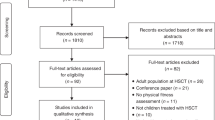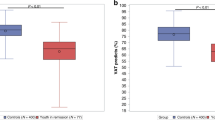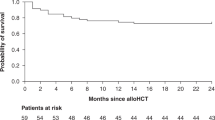Abstract
Peak oxygen uptake (VO2peak), a measure of aerobic exercise capacity, predicts mortality and morbidity in healthy and diseased individuals. Our aim was to determine VO2peak years after paediatric allogeneic haematopoietic SCT (HSCT) and to identify associations with baseline patient and donor characteristics, transplantation factors, pulmonary function and self-reported sports activity. In this cross-sectional, population-based study, we measured VO2peak, spirometry and diffusion capacity of the lung (DLCO) 3–10 years post HSCT. Z-scores were calculated by reference values from healthy subjects. Self-reported hours of sports activity were obtained by interview. We included 63 patients (mean age (range) 14.4 (7–24) years). HSCT patients exhibited lower mean VO2peak (−1.42 z-score, 95% confidential interval (−1.7; −1.1)) compared with healthy subjects (P<0.001). Sixteen patients (25%) had VO2peak values <−1.96 z-score. Low VO2peak was associated with reduced forced expiratory volume in 1 s (R2=0.11, P=0.009), reduced DLCO/VA (R2=0.09, P=0.01) and low physical activity (mean VO2peak z-score inactive group: −2.1 vs most active group: −1.1, P=0.02). No associations between VO2peak and diagnosis, donor type or GvHD were found. Although causes for reduced VO2peak may be multiple, our findings stress the need to focus on physical activity post HSCT to prevent lifestyle diseases and improve quality of life.
This is a preview of subscription content, access via your institution
Access options
Subscribe to this journal
Receive 12 print issues and online access
$259.00 per year
only $21.58 per issue
Buy this article
- Purchase on Springer Link
- Instant access to full article PDF
Prices may be subject to local taxes which are calculated during checkout




Similar content being viewed by others
References
Baker KS, Bresters D, Sande JE . The burden of cure: long-term side effects following hematopoietic stem cell transplantation (HSCT) in children. Pediatr Clin N Am 2010; 57: 323–342.
Uhlving HH, Bang CL, Christensen IJ, Buchvald F, Nielsen KG, Heilmann CJ et al. Lung function after allogeneic hematopoietic stem cell transplantation in children: a longitudinal study in a population-based cohort. Biol Blood Marrow Transplant 2013; 19: 1348–1354.
Milani RV, Lavie CJ, Mehra MR, Ventura HO . Understanding the basics of cardiopulmonary exercise testing. Mayo Clin Proc 2006; 81: 1603–1611.
Hogarty AN, Silber JH, Paridon SM . Cardiopulmonary exercise testing in evaluation of the functional capacity of survivors of childhood cancer. Prog Pediatr Cardiol 1998; 8: 109–119.
Blair SN, Kampert JB, Kohl HW, Barlow CE, Macera CA, Paffenbarger RS et al. Influences of cardiorespiratory fitness and other precursors on cardiovascular disease and all-cause mortality in men and women. JAMA 1996; 276: 205–210.
Myers J, Prakash M, Froelicher V, Do D, Partington S, Atwood JE . Exercise capacity and mortality among men referred for exercise testing. New Engl J Med 2002; 346: 793–801.
Lucía A, Earnest C, Pérez M . Cancer-related fatigue: can exercise physiology assist oncologists? Lancet Oncol 2003; 4: 616–625.
Van Brussel M, Takken T, Lucia A, van der Net J, Helders PJM . Is physical fitness decreased in survivors of childhood leukemia? A systematic review. Leuk Off J Leuk Soc Am Leuk Res Fund, UK 2005; 19: 13–17.
Jenney ME, Faragher EB, Jones PH, Woodcock A . Lung function and exercise capacity in survivors of childhood leukaemia. Med Pediatr Oncol 1995; 24: 222–230.
Larsen RL, Barber G, Heise CT, August CS . Exercise assessment of cardiac function in children and young adults before and after bone marrow transplantation. Pediatrics. Am Acad Pediatr 1992; 89 ( (Part 2) 722–729.
Eames GM, Crosson J, Steinberger J, Steinbuch M, Krabill K, Bass J et al. Cardiovascular function in children following bone marrow transplant: a cross-sectional study. Bone Marrow Transplant 1997; 19: 61–66.
Hogarty AN, Leahey A, Zhao H, Hogarty MD, Bunin N, Cnaan A et al. Longitudinal evaluation of cardiopulmonary performance during exercise after bone marrow transplantation in children. J Pediatr 2000; 136: 311–317.
Godfrey S . Physiological response to exercise in children with lung or heart disease. Arch Dis Child 1970; 45: 534–538.
Stephens P, Paridon SM . Exercise testing in pediatrics. Pediatr Clin N Am 2004; 51: 1569–1587 viii.
Eiberg S, Hasselstrom H, Grønfeldt V, Froberg K, Svensson J, Andersen LB . Maximum oxygen uptake and objectively measured physical activity in Danish children 6-7 years of age: the Copenhagen school child intervention study. Br J Sports Med 2005; 39: 725–730.
Hansen HS, Froberg K, Nielsen JR, Hyldebrandt N . A new approach to assessing maximal aerobic power in children: the Odense School Child Study. Eur J Appl Physiol Occup Physiol 1989; 58: 618–624.
Bugge A, El-Naaman B, Dencker M, Froberg K, Holme IMK, McMurray RG et al. Effects of a three-year intervention: the Copenhagen School Child Intervention Study. Med Sci Sports Exerc 2012; 44: 1310–1317.
Kolle E, Steene-Johannessen J, Andersen LB, Anderssen SA . Objectively assessed physical activity and aerobic fitness in a population-based sample of Norwegian 9- and 15-year-olds. Scand J Med Sci Sports 2010; 20: e41–e47.
Andersen LB, Henckel P, Saltin B . Maximal oxygen uptake in Danish adolescents 16–19 years of age. Eur J Appl Physiol Occup Physiol 1987; 56: 74–82.
Andersen LB, Haraldsdóttir J . Maximal oxygen uptake, maximal voluntary isometric contraction and physical activity in young Danish adults. Eur J Appl Physiol Occup Physiol 1993; 67: 315–320.
Miller MR, Hankinson J, Brusasco V, Burgos F, Casaburi R, Coates A et al. Standardisation of spirometry. Eur Respir J Off J Eur Soc Clin Respir Physiol 2005; 26: 319–338.
Macintyre N, Crapo RO, Viegi G, Johnson DC, van der Grinten CPM, Brusasco V et al. Standardisation of the single-breath determination of carbon monoxide uptake in the lung. Eur Respir J Off J Eur Soc Clin Respir Physiol 2005; 26: 720–735.
American Thoracic Society Single-breath carbon monoxide diffusing capacity (transfer factor). Recommendations for a standard technique—1995 update. Am J Respir Crit Care Med 1995; 152 ( (Part 1) 2185–2198.
Stanojevic S, Wade A, Stocks J, Hankinson J, Coates AL, Pan H et al. Reference ranges for spirometry across all ages: a new approach. Am J Respir Crit Care Med 2008; 177: 253–260.
Koopman M, Zanen P, Kruitwagen CLJJ, van der Ent CK, Arets HGM . Reference values for paediatric pulmonary function testing: the Utrecht dataset. Respir Med 2011; 105 15–23.
Filipovich AH, Weisdorf D, Pavletic S, Socie G, Wingard JR, Lee SJ et al. National Institutes of Health consensus development project on criteria for clinical trials in chronic graft-versus-host disease: I. Diagnosis and staging working group report. Biol Blood Marrow Transplant 2005; 11: 945–956.
R Development Core Team. R: A Language and Environment for Statistical Computing. R Foundation for Statistical Computing: Vienna, Austria, 2012.
Hovi L, Kurimo M, Taskinen M, Vettenranta J, Vettenranta K, Saarinen-Pihkala UM . Suboptimal long-term physical performance in children and young adults after pediatric allo-SCT. Bone Marrow Transplant 2010; 45: 738–745.
Ness KK, Bhatia S, Baker KS, Francisco L, Carter A, Forman SJ et al. Performance limitations and participation restrictions among childhood cancer survivors treated with hematopoietic stem cell transplantation: the bone marrow transplant survivor study. Arch Pediatr Adolesc Med 2005; 159: 706–713.
San Juan AF, Chamorro-Viña C, Moral S, Fernández del Valle M, Madero L, Ramírez M et al. Benefits of intrahospital exercise training after pediatric bone marrow transplantation. Int J Sports Med 2008; 29: 439–446.
Rosenhagen A, Bernhörster M, Vogt L, Weiss B, Senn A, Arndt S et al. Implementation of structured physical activity in the pediatric stem cell transplantation. Klin Pädiatr 2011; 223: 147–151.
Weisman IM, Marciniuk D, Martinez FJ, Sciurba F, Sue D, Myers J et al. ATS/ACCP Statement on cardiopulmonary exercise testing. Am J Respir Crit Care Med 2003; 167: 211–277.
Abid SH, Malhotra V, Perry MC . Radiation-induced and chemotherapy-induced pulmonary injury. Curr Opin Oncol 2001; 13: 242–248.
Astrand PO, Saltin B . Oxygen uptake during the first minutes of heavy muscular exercise. J Appl Physiol 1961; 16: 971–976.
Bassett DR, Howley ET . Limiting factors for maximum oxygen uptake and determinants of endurance performance. Med Sci Sports Exerc 2000; 32: 70–84.
Acknowledgements
This study was supported by grants from the Danish Child Cancer Association, the Danish Cancer Society, the Gangsted Foundation, The John and Birthe Meyer Foundation, the Anders Hasselbach’s Foundation against Leukemia, The Danish Lung Association, the Beckett Foundation and the Capital Region of Denmark. We thank Jacob Louis Marott from the Copenhagen City Heart Study for statistical assistance.
Author information
Authors and Affiliations
Corresponding author
Ethics declarations
Competing interests
The authors declare no conflict of interest.
Rights and permissions
About this article
Cite this article
Mathiesen, S., Uhlving, H., Buchvald, F. et al. Aerobic exercise capacity at long-term follow-up after paediatric allogeneic haematopoietic SCT. Bone Marrow Transplant 49, 1393–1399 (2014). https://doi.org/10.1038/bmt.2014.172
Received:
Revised:
Accepted:
Published:
Issue Date:
DOI: https://doi.org/10.1038/bmt.2014.172



